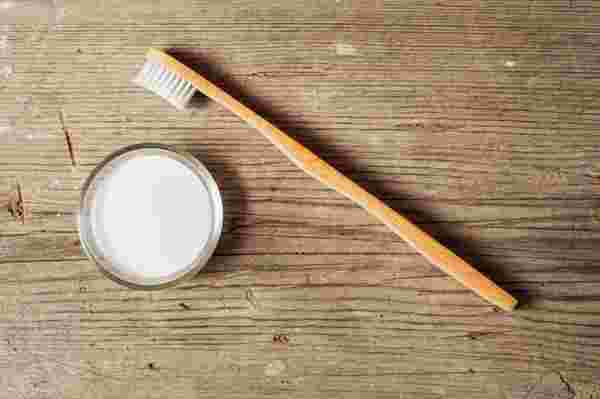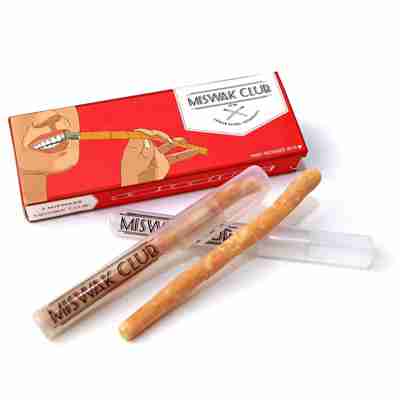
If you, like me, have ever been curious about the wide, weird world of alternative tooth care, please join me for what I thought would be a deep dive but which instead turns out to have only just skimmed the surface. But since I don’t think Apartment Therapy is looking for a weekly alternative dental care column (yet), this will likely be my only exploration.
***
Before the advent of the modern, nylon-bristled toothbrush, in 1938, people mostly chewed on sticks or used boar’s-bristle brushes to clean their teeth .
Both options are still available today, and apparently teeth-cleaning sticks might even be as good as (or better than) toothbrushes, anyway: A 2014 study in the North American Journal of Medical Science found that “[the] chewing stick has revealed parallel and at times greater mechanical and chemical cleansing of oral tissues as compared to a toothbrush.”
One of the chewing sticks mentioned in that study is the miswak teeth-cleaning twig, made from the Salvadora persica tree (a.k.a. the “ toothbrush tree “). A “traditional and natural alternative to the modern toothbrush,” per Wikipedia, the miswak “has a long, well-documented history and is reputed for its medicinal benefits.” ( Other twigs can also be used .)
From first learning about these sticks to clicking “buy” on Amazon took, for me, about eight minutes. (For the record, I’m not anti-dentist or anti-traditional-toothcare, but I enjoy checking out what’s going on in the world of hippie-alternatives.)

Among Amazon’s miswak-stick offerings is the Miswak Club Whitening Toothbrush ($18.99 for a pack of two), which is one of the two brands I ordered. (I also bought these .)
The miswak sticks were more intimidating in reality than they were in abstract, and it took a few days before I actually tried one, but ultimately it was pretty straightforward: I cut off an inch or so of bark around one end, as instructed, then chewed on it until the wood’s fibers became brush-like, then scrubbed it around like a regular toothbrush.
And it did feel surprisingly toothbrush-y, except it was harder to reach my back teeth, and it felt at times like some fibers were coming off in my mouth (they weren’t … always). A bonus is that it was fun to imagine I was in some kind of extreme camping situation.
I was a little put off by the miswak’s smell — it’s hard to describe, but it’s sort of sweetly earthy/musky/feet-like/perfumey (I’m sitting here huffing it as I write this) — which wasn’t mentioned on either of the sticks’ websites, although a representative of the Miswak Club sent a follow-up email suggesting that users soak their sticks in a glass of water with some peppermint oil if they wanted a mintier scent, which I’m trying now.
For anyone who’s not tempted by brushing their teeth with twigs but is still interested in old-school toothbrushes, or in generally avoiding plastic, there are still plenty of boar-bristle brushes, too — like the Fuchs ($16.75 on Amazon for a pack of 5), or the Swissco ($4.50 on Amazon for one), which I’ve been using for the past couple months. Swissco describes its bristles as “natural” on both its website and the box the toothbrush comes in, but I emailed the company to see what that meant specifically, and a representative confirmed that they are boar (the handle is horn).
I like the Swissco, although it was an adjustment, and some people complain in its Amazon reviews about bristles falling out occasionally (although that hasn’t been my experience so far).
As an aside, this is currently the No. 1 manual toothbrush on all of Amazon , and there’s a corn version , too. (The 5,000+ reviews makes it seem like I might be the last one to know this, though.)
While looking up alternative toothbrushes, I came across a listing for this jar of Teeth Whitening Charcoal Powder ($24.99 on Amazon), which I hadn’t been looking for but bought anyway because the reviews were so glowing and I wanted to see what black powder would look like in my mouth.
I’m not sure yet if it does anything, whitening-wise, but this was fun. (And it all washes out.)
Also charcoal-themed but non-messy: the Purity Brush ($10.99 on Amazon), made with binchotan charcoal-infused bristles and a recycled-bamboo handle. (Or, from its own description: “100% natural, plant based, BPA free, compostable, verified non-toxic and chemical free in Recycled Packaging.”) It felt great in my hand, but I’m still getting used to the wood’s drag on my skin, and my (so far unfounded) fear of splinters.
Over on the popular paleo/health site Mark’s Daily Apple, Mark Sisson recently outlined his daily body-care routines , including this information about his oral hygiene:
I hadn’t heard of either of those toothpastes, but I had recently come across a recipe for Homemade Remineralizing Toothpaste that I kept thinking about, so I used Sisson’s post as an excuse to buy the two ingredients for the DIY toothpaste that I didn’t already have — xylitol powder and calcium carbonate ($10.45 and $6.48 on Amazon, respectively). The amounts they came in will probably keep me in homemade toothpaste forever.
The recipe I found also called for baking soda, coconut oil and a few optional drops of an essential oil of your choice (I went with peppermint). (The coconut oil reminded me of the time I tried oil-pulling for a couple months, which was nice, although I’m not in a rush to take it back up.)
Mixing the toothpaste together, first with a fork and then my hand, took only a few minutes. (Read more about why people might want to use this toothpaste here .)
It tasted surprisingly normal — it didn’t lather, but it otherwise reminded me of traditional toothpastes. Well, that might not be completely true, but it was less of a departure than the miswak stick or the charcoal powder.
The woman who wrote the instructions for the DIY toothpaste said she used a popsicle stick to scoop the mixture up and onto her toothbrush, but I just used my fingers. (If I got a tube to put it in — like these ones — I imagine it might be easier to continue using.)
I’m not sure how alternative this is, but for the past year, my main toothbrush has been the goofy-ergonomic Radius ($8.90 on Amazon), which at first felt awkwardly large but now I love.
As far as biodegradable toothbrushes go, there are various options, and with various biodegradable parts, like the Bogobrush ($14.25) and the Purity Brush ($10.99 on Amazon, mentioned earlier). Here’s a blog post that goes even deeper on all of this. Maybe even past the point of no return.
There are also a bunch of bamboo toothbrushes on Amazon, like these Brush with Bamboo ones ($15 on Amazon for a pack of 4, above), which have this sort of surreal description:
And that’s as far as I went, for now.
At the end of this, I’m still using my Radius, my Swissco, and, now, the black-bristled Purity Brush, too (rotating among them feels sort of queenly), although my teeth look and feel pretty much the same as they always have. In theory I’m still using that homemade toothpaste and that charcoal powder, although in reality they’re currently sitting unused on a table. The miswak stick was maybe a bridge too far, although it helped me especially enjoy this WikiHow piece on brushing with washcloths, paper towels, [other] twigs and fingers .
Have you ever been tempted by an alternative toothbrush-type item? How did it go?












